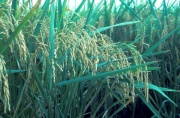Difference between revisions of "Rice husk"
Jump to navigation
Jump to search
m (Text replace - "== Authority ==" to "== Sources Checked for Data in Record ==") |
m (Text replace - "\[http:\/\/cameo\.mfa\.org\/materials\/fullrecord\.asp\?name=([^\s]+)\s(.*)\]" to "$2") |
||
| Line 2: | Line 2: | ||
== Description == | == Description == | ||
| − | The outer seed covering from rice grains, a cereal obtained from genus ''Oryza sativa''. Rice husks are separated from the seed during milling. When burnt, the husks can yield an [ | + | The outer seed covering from rice grains, a cereal obtained from genus ''Oryza sativa''. Rice husks are separated from the seed during milling. When burnt, the husks can yield an [[ash%20%28residue%29|ash]] which is greater than 95% [[silica|silica]]. Rice husk ash has been used as a [[filler|filler]], an [[abrasive|abrasive]], and as a [[refractory%20material|refractory material]]. |
== Comparisons == | == Comparisons == | ||
Revision as of 10:54, 10 May 2016
Description
The outer seed covering from rice grains, a cereal obtained from genus Oryza sativa. Rice husks are separated from the seed during milling. When burnt, the husks can yield an ash which is greater than 95% Silica. Rice husk ash has been used as a Filler, an Abrasive, and as a Refractory material.
Comparisons
Properties of Common Abrasives
Sources Checked for Data in Record
- Robert Fournier, Illustrated Dictionary of Practical Pottery, Chilton Book Company, Radnor, PA, 1992
- Van Nostrand's Scientific Encyclopedia, Douglas M. Considine (ed.), Van Nostrand Reinhold, New York, 1976
- Random House, Webster's Encyclopedic Unabridged Dictionary of the English Language, Grammercy Book, New York, 1997
- The American Heritage Dictionary or Encarta, via Microsoft Bookshelf 98, Microsoft Corp., 1998
